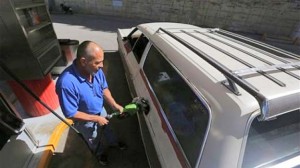For drivers in most parts of the world it might seem like a fantasy, but for those in oil-rich Venezuela, nickel gas has long been the norm – and it’s encouraged the sort of fascination with fuel-guzzling vehicles that were common in the U.S. back in the 1970s.
But struggling to deal with a worsening smog problem, as well as increasing financial woes, the Latin American nation’s new President Nicolas Maduro has been dropping strong hints that it’s time to finally boost fuel prices that have been frozen at 5 cents – and even less at black-market rates – for the last two decades.
“As an oil nation, Venezuelans should have a special price advantage for hydrocarbons compared to the international market,” Maduro, who replaced Hugo Chavez after the Socialist icon’s death last year, said during a December 18th speech. “But it has to be an advantage, not a disadvantage. What converts it into a disadvantage is when the tip you give is more than what it cost to fill the tank.”
Like Americans prior to the twin oil shocks of the 1970s, Venezuelans view cheap gasoline as a birthright, notes the Associated Press. And they’ve shown an angry resistance in the past whenever politicians have even hinted at ending the massive subsidies behind nickel gas. That included days of violent rioting in 1989. Even Chavez declined to take action, despite a $12.5 billion annual price tag, and despite the shortages of other essential consumer goods that have developed as Venezuela’s economy has begun to falter over the last several years.
(Supplies rising, Americans may be in for some long-term relief from rising fuel prices. Click Here for the story.)
But with the nation’s currency collapsing as inflation tops 50%, Chavez’s successor Maduro seems to have few options but to make the almost certainly unpopular move – which could help reduce a federal budget deficit now reaching 11.5% of Venezuela’s gross domestic product.
The big question Venezuelans are waiting to see answered is just how much fuel prices will rise. For his part, the new president has been testing the waters to see how much citizens might be willing to accept.
Cheap gas isn’t unique to Venezuela. Saudi Arabian drivers pay just 45 cents, with motorists in neighboring Kuwait shelling out 80 cents. But the going rate at a pump in Caracas is estimated to be only about 12% of what it actually costs to pump and refine the fuel – about 40 cents a gallon.
“Prices are so cheap in Venezuela that they may make Saudi Arabia and Iran look expensive,” Lucas Davis, a University of California-Berkeley energy specialist, told the AP.
(Ford’s new F-150 to use light, fuel-saving aluminum. Click Herefor the story.)
Not only does cheap gas contribute to Venezuela’s worsening economic plight but it also harms the environment, something readily apparent on the capital city’s clogged and smog-choked streets.
With little reason to switch, motorists frequently opt for leftover muscle cars and trucks that would not only be too old but far too inefficient to operate anywhere else in the world.
Barring the sort of deadly riots that followed a proposed fuel price hike 25 years ago, most observers expect Maduro to make a move in the coming months. It helps that the government has won a series of critical elections in recent months – albeit with results questioned by many opponents both in and outside Venezuela.
The government doesn’t face another major test at the polls until 2015 and Maduro’s administration appears to be hoping that by then the public will have come to accept an increase that will likely maintain Venezuela’s position as offering some of the lowest fuel prices in the world.

